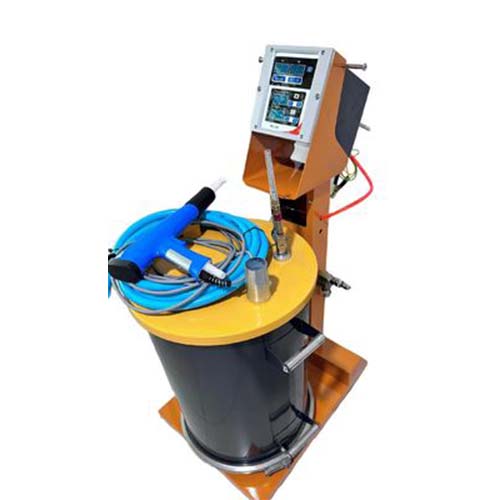Powder Coated Machine sees rising demand in small manufacturing, auto repair, and custom metalwork, valued for durable, low-waste finishes. Prices vary: entry-level models for small workshops start at $1,500, while mid-range units with advanced controls cost $3,000–$8,000; industrial-grade machines exceed $15,000, based on capacity and automation.

Powder Coated Machine suits projects like custom metal signage, machinery parts repair, or small-batch furniture production. It handles items from 5cm to 2m in size, making it ideal for businesses needing flexible coating without mass production. Projects benefit from consistent color matching and scratch-resistant finishes, reducing rework compared to manual painting. Hobbyists use it for restoring vintage metal items, while local shops rely on it for on-demand custom coatings.
Powder Coated Machinestreamlines surface treatment through integrated steps. First, pre-treat the substrate: degrease with solvent, sandblast to remove rust, and dry—ensuring powder adheres. The machine’s spray module applies electrostatically charged powder, evenly covering curves and edges. Post-spray, its curing component (often a built-in oven or heat plate) melts powder at 160–220°C, forming a hard, uniform layer. This tech reduces manual labor, ensuring each piece meets quality standards with minimal skill required.
Powder Coated Machine is a compact system designed to apply and cure powder coatings on metal and heat-resistant surfaces. It combines a powder sprayer, electrostatic generator, and curing unit in one setup, eliminating the need for separate equipment. Unlike large industrial lines, it operates on standard power, fitting in workshops or garages, making it accessible for small businesses and serious hobbyists seeking professional-grade results.
Spray Module: The core of Powder Coated Machine, it holds and dispenses powder via a handheld or automated gun. It uses electrostatic charge to bind powder to surfaces, with adjustable flow rates to control coating thickness—critical for items like tool handles or metal frames.
Curing Unit: Integrated into Powder Coated Machine, it uses electric or gas heat to cure powder. Smaller models have batch ovens for 1–5 items, while larger units feature conveyor belts for continuous processing, maintaining precise temperatures to avoid under or over-curing.
Control Panel: Found on Powder Coated Machine, it adjusts spray pressure, curing time, and temperature. User-friendly dials or digital displays let operators tweak settings for different powders (polyester, epoxy) and substrates, ensuring consistency across projects.
Powder Coated Machine offers key benefits for users. Its all-in-one design cuts setup time—no need to move items between separate spray and cure stations. The finish resists chemicals, UV rays, and impact, extending product lifespan. It reduces waste: unused powder is recyclable, lowering material costs. For small-scale operations, it balances quality and affordability, avoiding the high expense of industrial systems while delivering professional results.
How to select the right Powder Coated Machine for small business use?
Selecting the right Powder Coated Machine for small business starts with project size: measure your largest item to ensure it fits the curing unit. Choose a spray module with adjustable flow (0.5–2 kg/h) for versatility—handles both small parts and larger panels. Opt for a curing unit with digital temperature control (160–220°C) to match different powder types. Check power requirements: 220V works for most workshops. Prioritize models with 1–2 year warranties, as durability matters for daily use. Test with sample powder to confirm finish quality before buying.
How to maintain Powder Coated Machine to prevent breakdowns?
Maintaining Powder Coated Machine prevents breakdowns through regular checks. Clean the spray module weekly: wipe the gun nozzle with a dry cloth, clear powder hopper clogs with a soft brush. Inspect curing unit heating elements monthly—dust buildup reduces efficiency, so vacuum gently. Lubricate moving parts (conveyor belts, if present) quarterly to avoid jams. Calibrate the control panel every 6 months using a test thermometer to ensure temperature accuracy. Store powder in sealed containers near the machine to keep it dry, as moisture damages the spray system.
How to fix peeling coatings with Powder Coated Machine?
Peeling coatings with Powder Coated Machine often stem from poor pre-treatment or curing. First, check if the substrate was properly cleaned—oils or rust prevent adhesion, so re-degrease and sandblast. Adjust the curing unit: under-curing (too low temp or short time) causes weak bonds, so increase to 180°C for 15–20 minutes. Ensure the spray module’s electrostatic charge is working—test with a metal sheet; powder should cling evenly. If the gun is worn, replace the nozzle, as uneven spray leads to thin spots that peel.
How to use Powder Coated Machine for outdoor furniture projects?
Using Powder Coated Machine for outdoor furniture starts with pre-treating aluminum or steel frames: sand to remove old paint, clean with degreaser, and dry fully. Load UV-resistant powder (polyester works best) into the machine’s hopper. Set spray flow to 1 kg/h and hold the gun 15cm from the frame, moving steadily to cover all surfaces. Cure in the unit at 200°C for 20 minutes—this ensures the coating resists rain and sun. Let cool completely before handling; avoid stacking items while warm to prevent scratches. Repeat for small parts like hinges to ensure full protection.
How to compare prices of Powder Coated Machine models effectively?
Comparing prices of Powder Coated Machine models involves checking total value, not just upfront cost. List must-have features: curing unit size, spray capacity, warranty length. Compare similar specs—e.g., a 2kg/h sprayer with 50cm curing space. Check for hidden costs: some models need separate compressors, adding $500–$1,000. Read user reviews on durability; a $5,000 machine lasting 10 years is cheaper long-term than a $3,000 model failing in 3. Ask suppliers about replacement parts availability—high-cost parts (heating elements) should be easy to source to avoid downtime.
Links:Powder Coating Machine,Powder Coat Machine,Powder Coating Machine For Sale,Electrostatic Powder Coating Machine,Portable Powder Coating Machine,Powder Coating Line Suppliers,Powder Coating Line Manufacturers,Powder Coating Line,Powder Coat Curing Oven,Industrial Powder Coating Ovens,Small Powder Coating Ovens,Powder Coating Oven Manufacturers,Industrial Powder Coating Equipment,Powder Coating Equipment,Industrial Powder Coating Booth,Homemade Powder Coating Booth,,Diy Powder Coating Booth,Powder Coating Spray Booth,Powder Coating Booth
 Leave us message
Leave us message

